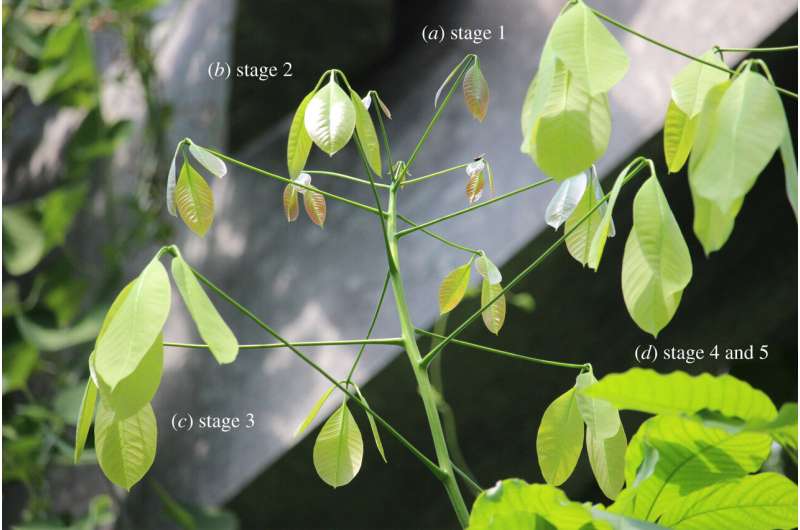Leaf transition: leaves from the tip of a branch of Hevea brasiliensis tree (height greater than 10 m) with almost vertically drooping leaves during young stages; the leaves gradually position themselves more horizontally as they grow. The image shows (a) young leaves at stage S1, (b) leaves in transition to stage S2 with the surface progressing from shiny brown to dull pale green acropetally, (c) leaves at stage S3 and (d) adult leaves (S4 and S5). Credit: Royal Society Open Science (2020). DOI: 10.1098/rsos.201319
A team of researchers at the University of Freiburg, has found that at least one kind of plant has leaves that grow slippery as it ages in an apparent attempt to ward off leaf-eating insects. In their paper published in the journal Royal Society Open Science, the group describes their study of rubber tree plant leaves and their impact on Colorado potato beetles.
Prior research has shown that plant evolution has quite often involved developing attributes that ward off animals and insects that wish to use them as a food source. Some plants produce strong odors, sticky substances, or in some cases, thorns. In this new effort, the researchers have found that plants may also develop leaf characteristics that help them ward off leaf-eating insects, such as slipperiness.
In this new effort, the researchers were studying leaf cuticles—coatings that cover leaves to protect them and to hold in moisture. In so doing, they found that many plant species have microscale wrinkle-like structures in their leaf coatings. Taking a closer look at rubber tree plant leaves, they found small wrinkles in the cuticles that appeared to make the leaves more slippery than they would be otherwise.
To find out if this trait might have developed as a means to ward off insects, the researchers carried out an experiment—they connected tiny traction sensors to the forewings of Colorado potato beetles and then let them crawl around on silicone leaf copies of real leaves from a rubber tree plant (using artificial leaves made it easier to study slipperiness without accounting for the slipperiness of the waxy coating).
The researchers found that as the wrinkles in the cuticles were introduced over time (simulating the leaves maturing), the beetles found it more difficult to walk—they kept slipping. The researchers found that the wrinkles had a significant impact on the ability of the beetles to walk on the leaves.
The researchers suggest their findings could play a role in the development of a pesticide enhancement or even a replacement—genetically modifying crop plant leaves to be more slippery.
More information: Venkata A. Surapaneni et al. Spatio-temporal development of cuticular ridges on leaf surfaces of Hevea brasiliensis alters insect attachment, Royal Society Open Science (2020). DOI: 10.1098/rsos.201319
Journal information: Royal Society Open Science
© 2021 Science X Network























